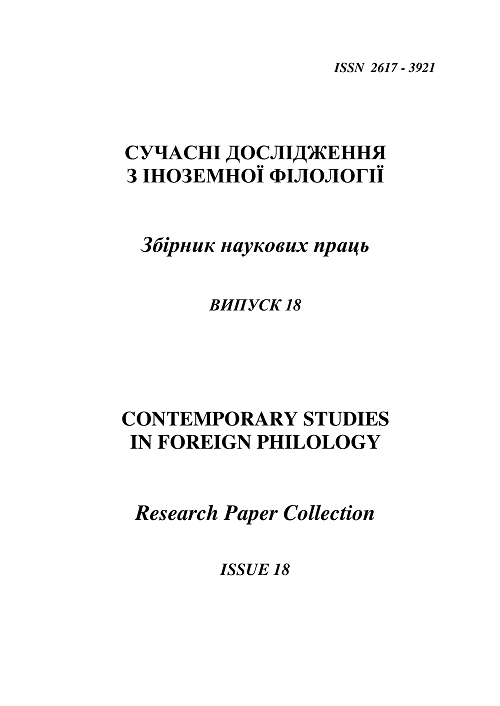Incorporation of traditional African artifacts in selected works by Loïs Mailou Jones as a reflection of historical identity
DOI:
https://doi.org/10.24144/2617-3921.2020.18.250-261Анотація
This paper deals with the analysis of selected works of Loïs Mailou Jones, a prominent visual artist of Harlem Renaissance. The key element determining the selection of particular works was the presence of African tribal art features in these paintings. The intention was to prove that the mentioned artifacts became a tool for the artist that enabled her to reflect upon the unequal position of African Americans within society, their identity, as well as upon the heritage of the ancestral Africa. Thus, the two works selected for the analysis are Les Fetiches and Two Faiths, produced in the late 1930s and the early 1940s respectively. The main reason the paper focuses on this topic is frequent absence of visual art of Harlem Renaissance in publications dedicated to Modern art. Similarly, the visual art of Harlem Renaissance has never been met with the same level of appreciation as literature or music representative of this era. Yet, it is not the intention to trace reasons why it is so; instead, the paper aims to provide a contribution to this often overlooked topic. It is important to say that the paper approaches the theme of visual art not from the perspective of art theory. Instead, the analysis relies on historical context and the philosophical tendencies of the first decades of the 20th century that enabled the artist to approach the notion of identity from a unique angle. To describe the methodology being used, it is a combination of a descriptive method related to observation of formal aspects of paintings, yet, these features are interpreted within the already mentioned historical context. The focus is therefore more on the paintings’ meaning, traceable connotations, rather than on the artistry itself. The contribution of the paper thus resides in in-depth analysis of the two works within the framework of Harlem Renaissance, Négritude movement and affiliated philosophical strands of the first decades of the 20th century with the accent on the use of indigenous African artifacts. Moreover, the paper may be also useful to readers interested in frequently unheeded topic of visual art of Harlem Renaissance.
Keywords: identity, Harlem Renaissance, artifact, religion, masks, heritage.
Посилання
Awolalu J.O. What is African Religion Tradition? Studies in Comparative Religion. Vol. 9, no. 1, 1976. url=http://www.studiesincomparativereligion. com/public/articles/What_is_African_Traditional_Religion-by_Joseph_ Omosade_Awolalu.aspx
Birch A.L. Harlem and the First Black Renaissance. Harold Bloom: The Harlem Renaissance. Chelsea House Publishers, 2004.
Böhme H. Fetishism and Culture: A Different Theory of Modernity. De Gruyter, 2014
Diagne Souleymane Bachir. Négritude. The Stanford Encyclopedia of Philosophy. 2016 url=://plato.stanford.edu/cgi-in/encyclopedia/ archinfo.cgi?entry=negritude
Earle S. The Wide-Ranging Significance of Lois Mailou Jones. Women Artists of the Harlem Renaissance. University Press of Mississippi. 2014
Locke A. L. The New Negro: An Interpretation” Johnson Reprint Corporation, 1999
Middleton J. New Encyclopedia of Africa. Vol. 1, Charles Scribner & Sons, 2007
Rowell Ch. H. An Interview with Lois Mailou Jones. Callaloo. No. 37, 1989 url=://www.jstor.org/stable/2931576?seq=1#page_scan_tab_contents
Encyclopaedia Britannica. “Negritude” Encyclopaedia Britannica, 2002 url= https://www.britannica.com/topic/Negritude
##submission.downloads##
Номер
Розділ
Ліцензія
Автори, які публікуються у цьому журналі, погоджуються з наступними умовами:
- Автори залишають за собою право на авторство своєї роботи та передають журналу право першої публікації цієї роботи на умовах ліцензії Creative Commons Attribution License, котра дозволяє іншим особам вільно розповсюджувати опубліковану роботу з обов'язковим посиланням на авторів оригінальної роботи та першу публікацію роботи у цьому журналі.
- Автори мають право укладати самостійні додаткові угоди щодо неексклюзивного розповсюдження роботи у тому вигляді, в якому вона була опублікована цим журналом (наприклад, розміщувати роботу в електронному сховищі установи або публікувати у складі монографії), за умови збереження посилання на першу публікацію роботи у цьому журналі.
- Політика журналу дозволяє і заохочує розміщення авторами в мережі Інтернет (наприклад, у сховищах установ або на особистих веб-сайтах) рукопису роботи, як до подання цього рукопису до редакції, так і під час його редакційного опрацювання, оскільки це сприяє виникненню продуктивної наукової дискусії та позитивно позначається на оперативності та динаміці цитування опублікованої роботи (див. The Effect of Open Access).

